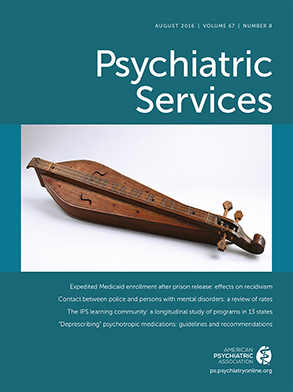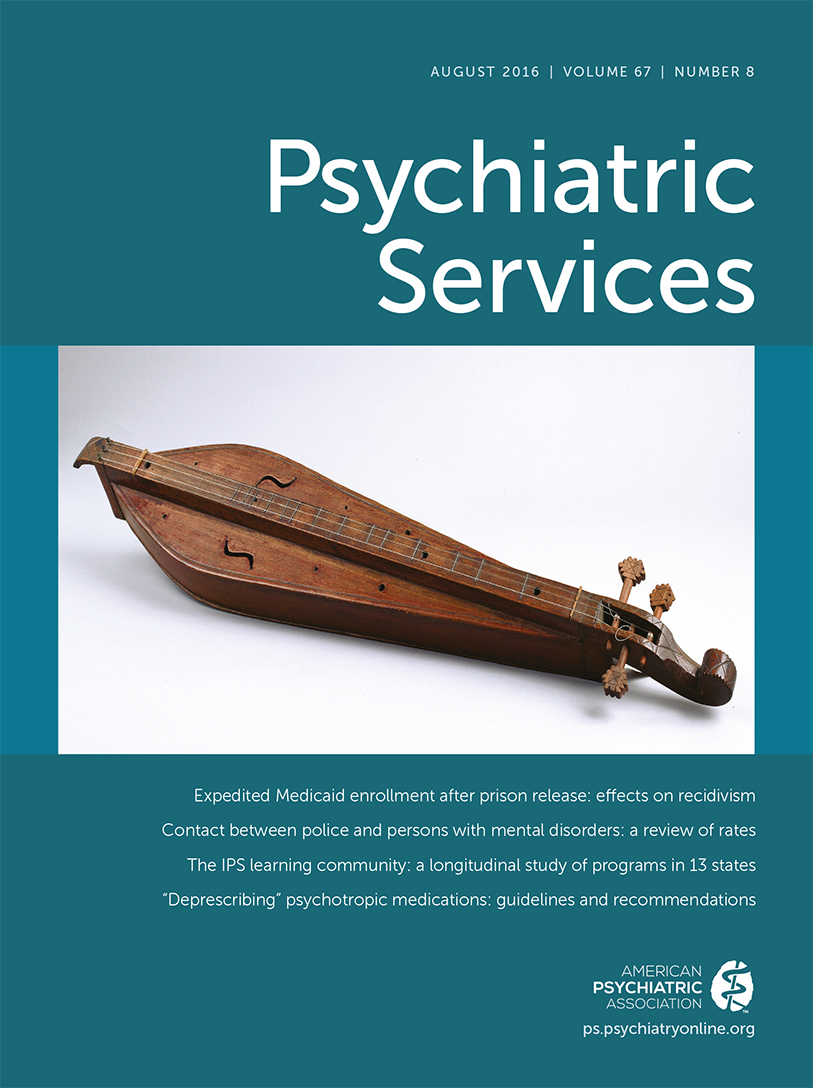FQHCs are growing rapidly, and 21.7 million patients were treated in FQHCs in 2013. The number treated has increased by 75% since 2003 (
1), and FQHCs now comprise the largest primary care network in the United States. They are an outgrowth of an initiative to provide affordable, high-quality, primary care–focused medical treatment through community health centers. An FQHC can be a single stand-alone clinic or part of a collection of clinics under a single administrative umbrella. FQHCs are nonprofit health centers that must treat an underserved population, offer a sliding fee scale, and have an ongoing quality assurance program. FQHCs disproportionately serve persons from racial-ethnic minority groups, those with low incomes, and those with public insurance or no insurance. FQHCs qualify for enhanced reimbursement from Medicare and Medicaid, among other benefits, in exchange for federal oversight.
FQHCs and behavioral health care.
FQHCs are intended to provide comprehensive services, including mental health care. A 2010 survey by the National Association of Community Health Centers reported that 71% of FQHCs provide mental health services and 20% provide substance abuse treatment services (
2). Social workers constitute the largest portion of the mental health workforce, at 31%, and psychiatrists account for only 7%. Staffing varies greatly from clinic to clinic. Most FQHCs employ one or fewer full-time-equivalent psychiatrists, and many employ fewer than one half-time equivalent. Both mental health services and substance abuse services are unevenly distributed across the nationwide FQHC network and often are insufficient to meet community needs. Substance abuse treatments at many FQHCs consist only of screening and counseling within the context of primary care visits, without a dedicated program or specialist support (
3).
FQHCs often serve as the primary medical home for persons with severe and persistent mental illness. However, as primary care–focused health centers, FQHCs typically function best as a gateway to more intense community-based treatment for these patients. Community mental health centers, assertive community treatment teams, and other targeted programs better meet the needs of patients with severe mental illness. However, because of the distinct missions and administrative structures of these organizations, cooperation is often haphazard. When these organizations work together, treatment can be organized and information shared—and patients benefit.
Currently, most FQHCs use traditional on-site psychiatric care clinics. This is supported by the fee-for-service payment system and the training of the current psychiatric workforce, along with the administrative structure and personnel patterns of FQHCs. Referrals can come from within the FQHC and its affiliated clinics. Community walk-ins typically require triage or an evaluation by another professional to ascertain whether these individuals are appropriate for referral. Psychiatric clinics at an FQHC allow patients to receive specialist treatment within their community that is better coordinated with primary care than if they were referred to a typical psychiatric private practice.
Psychiatric services provided in FQHCs are important, but the availability of these services is erratic, and the system reinforces divided primary care and psychiatric care because of a lack of reimbursed time to coordinate treatment, lack of payment for indirect consultation, and the inability to utilize same-day billing (
2).
There is a movement toward team-based health care delivery. The regularity with which patients who have mental health symptoms are seen in primary care, along with the strong connection between general medical health and mental health, has prompted acceptance of the need for increased psychiatric support in primary care settings, including FQHCs. In addition, passage of the Mental Health Parity and Addiction Equity Act of 2008 and the Affordable Care Act in 2010 has intensified the call for improved and expanded care while simultaneously increasing patient loads at FQHCs (
4). Thus new opportunities exist to promote health system changes that can better integrate mental health care into primary care, increase efficiency, control costs, and optimize patient outcomes.
Collaborative care is an emerging model that spreads psychiatric care more efficiently and better coordinates mental health and primary care compared with traditional models of care. In collaborative care, the psychiatrist’s role changes into that of a specialist consultant. The primary care provider writes prescriptions and directs management. Psychiatric care becomes a standard part of the clinic, with fewer barriers to care, including quicker referrals and reduced stigma (
5). Collaborative care can occur on site through direct consultation at the FQHC or through teleconferencing (telepsychiatry) (
6,
7). Direct evaluation of a patient by the psychiatrist has advantages; the knowledge and skill sets of both providers can be integrated, and therapeutic techniques can be modeled. The psychiatrist’s collaborative role as an indirect consultant can include performing chart reviews, discussing cases at treatment team meetings, or providing “on call” phone or telepsychiatric support.
Growing evidence supports the feasibility and advantages of collaborative care systems. However, implementation of collaborative approaches to treatment for larger populations is filled with unknowns. For example, much of the research focuses on a single disorder, such as depression. In addition, collaborative care models that require on-site psychiatric services are limited by workforce distribution. Telepsychiatric or indirect collaborative care programs will fit best when direct access to psychiatric care is limited, for example, in rural clinics. Academic medical centers appear to be a good fit for administering these collaborative programs.
Expansion of collaborative systems can ensure that all FQHCs have access to indirect specialist consultation at a minimum. But even with organized collaborative systems, the high absolute patient-to-psychiatrist ratio requires that FQHCs must thoughtfully use psychiatric services. The referral process will have to be carefully designed, and access may be restricted to patients with more severe illness. Thus FQHCs need both collaborative care systems and complementary team-based approaches to treat patients with mental health needs, most of whom will never see a psychiatrist.
Maximizing the benefits of collaborative care.
Care management is a natural companion to collaborative care (
8). Psychiatrists who work in collaborative models typically serve more patients, provide care in multiple clinics, and communicate with many treatment providers. In care management, a team member fills a number of supportive and treatment roles, such as coordinating referrals, providing patient education, tracking data, and ensuring compliance and follow-up. Behavioral health consultants can be embedded in primary care teams (
8). Placing behavioral health providers alongside their primary care colleagues appears to be a promising method to support comprehensive treatment for large populations within their medical home.
In addition, FQHCs could expand preventive and supportive services in primary care through behavioral health “well visits” or organized, family-based health coaching to establish relationships, provide education, support families, and aid in building healthy habits. With the diverse patient populations, settings, and staffing arrangements in FQHCs, a mix of clinical and administrative support solutions will be needed as team-based care models develop. Regardless of what administrative or staffing improvements FQHCs utilize, the approach to behavioral health problems also needs to be updated.
Disadvantaged and underserved patients experience financial, environmental, and social stressors that negatively affect their health. FQHC staff need sufficient time to get to know their patients, cultivate trusting and positive relationships with them, and look for solutions together. Many current treatment approaches based on symptoms and rapid diagnosis often lead to pharmaceutical interventions that do not address the causes of problems. This includes the use of antidepressants based on symptom checklists without comprehensive evaluation (
9) and prescribing attention-deficit hyperactivity medications and antipsychotics for traumatized children.
Alternatives to diagnostically based treatment in primary care offer opportunities to utilize high-value, practical, evidence-informed treatments (
10). For most patients, interventions targeting the presenting behavioral health problem can be combined with social supports and mind-body techniques as first-line treatment. Patient-directed care, sometimes referred to as self-help, should be included. Excellent evidence-based patient-guided treatments can be chosen from published reviews (
11). Lifestyle change should be a standard part of mental health treatment. Significant mental health symptoms can be caused by a sedentary lifestyle; nutrient poor, hypercaloric diets; and sensory overload, especially from the overuse of electronics (
12).
Treatment can be aided by the use of technology. Assessing patient knowledge, increasing motivation, tracking behavioral change, and educating patients all can be done electronically via computer, smartphone, or a tablet either at home, in group classes, or in the waiting room.
Ideally, an FQHC is an integral part of the community, working alongside local government agencies, schools, and other civic resources. Local environments are closely tied to health outcomes. This is especially true within the primary unit of our society, the family. The FQHC system already recognizes the family milieu’s strong influence on health, with policies supporting pregnant women and infants. But FQHCs should expand support for mothers of young children. Parent-child therapies and parent training should be available where families receive primary health care. Programs that support, educate, and treat parents can help ensure their children’s positive early-life experiences. Adverse early-life experiences, especially childhood abuse and neglect, cause a myriad of general medical and mental health problems. Therefore, improving mother-child attachment and reducing child abuse yield more positive results, including in cost savings, than any other policy (
13). Furthermore, as the population ages, care for elderly patients and caregiver support are an increasing challenge. FQHC systems of care need to support patients and families across the lifespan.
Making the FQHC a healing space means including all clinic staff in the mission to promote health and well-being. Policies should encourage employee wellness through family supports, exercise programs, healthy-cooking classes, and encouragement to practice breathing exercises or mindful meditation. These policies will increase employee productivity and decrease burnout. Healthy FQHC employees are the best advertisement that individuals can adapt and thrive, even in disadvantaged communities.

